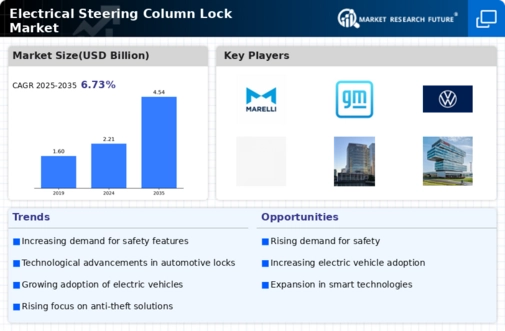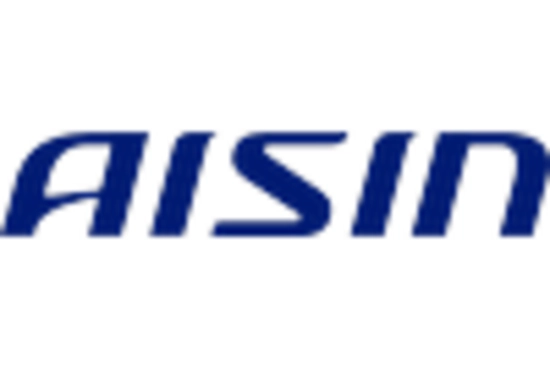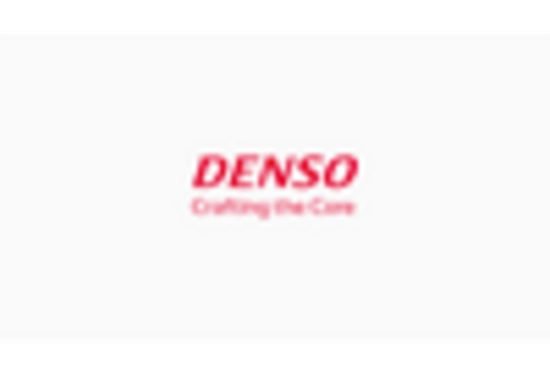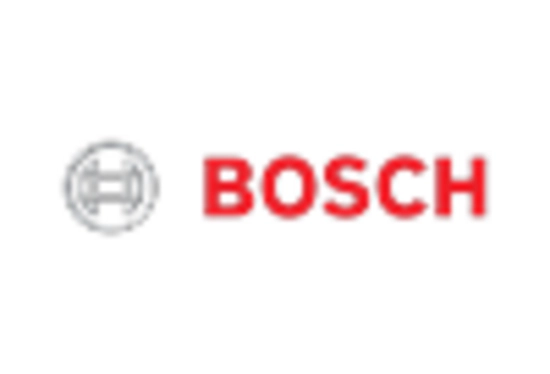Rising Demand for Vehicle Safety Features
The Electrical Steering Column Lock Market is experiencing a notable increase in demand for advanced safety features in vehicles. As consumers become more aware of vehicle security, manufacturers are integrating electrical steering column locks to enhance anti-theft measures. According to recent data, the automotive sector has seen a surge in the adoption of electronic locking systems, with projections indicating a growth rate of approximately 7% annually. This trend is driven by the need for improved vehicle protection, as theft rates continue to rise in various regions. Consequently, the Electrical Steering Column Lock Market is positioned to benefit from this heightened focus on safety, as automakers prioritize the incorporation of innovative locking mechanisms to meet consumer expectations.
Increasing Production of Electric Vehicles
The rise in electric vehicle production is significantly impacting the Electrical Steering Column Lock Market. As the automotive industry shifts towards electrification, the demand for advanced security features, including electrical steering column locks, is expected to increase. Electric vehicles often incorporate sophisticated electronic systems, making them more susceptible to cyber threats and theft. Consequently, manufacturers are focusing on enhancing security measures to protect these vehicles. Market analysis indicates that the electric vehicle segment is projected to grow at a compound annual growth rate of over 20% in the coming years. This growth presents a substantial opportunity for the Electrical Steering Column Lock Market, as automakers seek to implement robust locking mechanisms to safeguard their electric models.
Regulatory Compliance and Safety Standards
The Electrical Steering Column Lock Market is influenced by stringent regulatory compliance and safety standards imposed by various authorities. Governments worldwide are implementing regulations that mandate the inclusion of advanced locking systems in vehicles to enhance safety and reduce theft. For instance, regulations in several regions require manufacturers to adopt electronic steering locks as part of their vehicle security systems. This regulatory landscape is likely to propel the demand for electrical steering column locks, as automakers strive to meet compliance requirements while ensuring consumer safety. The market is expected to witness growth as manufacturers invest in developing innovative locking solutions that adhere to these evolving standards, thereby reinforcing the importance of safety in the Electrical Steering Column Lock Market.
Technological Advancements in Automotive Systems
Technological advancements play a pivotal role in shaping the Electrical Steering Column Lock Market. The integration of sophisticated electronic systems in vehicles has led to the development of more efficient and reliable steering column locks. Innovations such as keyless entry and remote locking systems are becoming increasingly prevalent, enhancing user convenience and security. Market data suggests that the adoption of these technologies is expected to grow significantly, with a projected increase in the use of electronic locks in new vehicle models. This shift towards advanced automotive technologies not only improves the functionality of steering column locks but also aligns with consumer preferences for modern, tech-savvy vehicles, thereby driving growth in the Electrical Steering Column Lock Market.
Consumer Preference for Enhanced Vehicle Features
Consumer preferences are evolving, with a growing inclination towards vehicles equipped with enhanced features, including advanced locking systems. The Electrical Steering Column Lock Market is benefiting from this trend, as consumers increasingly prioritize security and convenience in their vehicle choices. Market Research Future indicates that a significant percentage of buyers are willing to pay a premium for vehicles that offer superior safety features, including electronic steering locks. This shift in consumer behavior is prompting manufacturers to innovate and incorporate advanced locking technologies into their designs. As a result, the Electrical Steering Column Lock Market is likely to experience sustained growth, driven by the demand for vehicles that not only provide mobility but also ensure enhanced security and user experience.

















Leave a Comment